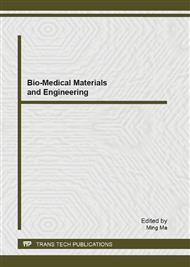p.139
p.144
p.149
p.154
p.160
p.167
p.172
p.177
p.182
The Research on Deproteinized Techniques of Bio-Calcium Chitin
Abstract:
0Objective :This study is to retain the biological calcium in the crab shell, stripped of protein, calcium biological chitin chitin that is retained characteristics have unique biological calcium carbonate mosaic structure. the traditional preparation of chitin commoly adopts acid to remove calcium carbonae,applys alkali to extract protein, while inorgaic calcium salts is mixed with it as a source of calcium or an enhancement.Methods :Superfine pulverizing technology is used to smash crab shell to D50, which is 8.05 μm to get different size of crab shell powder through screen separation. The primary element of crab shell is calcium carbonate, chitin as well as protein. The content of protein is a significant indicator of industrial application of crab shell powder. Different size of crab shell powder is processed deproteinizedly,through hot alkali methodenzyme hydrolysis methodhot alkali method assisting microwave respectively. Results: Research result shows that the lower sizes of crab shell powder induce the higher effect of deproteinized processing method. The protein residual amount in crab shell powder of particle size D50 of 8.05 μm being processed in hot alkali for 3 hours is 0.097 %, while time being processed by microwave assisting is significantly reduced, making 20 minutes possible for the same result. Conclusions: Particle size of crab shell powder after superfine pulverizing is small, and deproteinization can be achieved by various methods, while retaining original chitin and biological calcium.
Info:
Periodical:
Pages:
160-166
Citation:
Online since:
August 2013
Authors:
Price:
Сopyright:
© 2013 Trans Tech Publications Ltd. All Rights Reserved
Share:
Citation:


